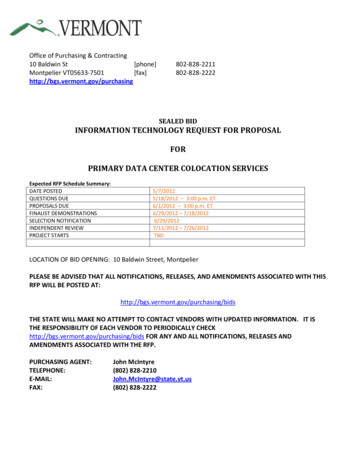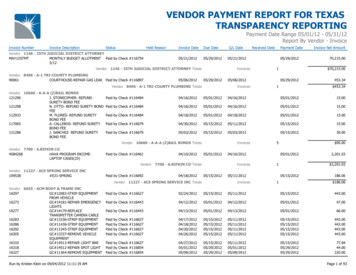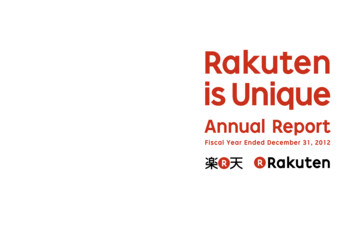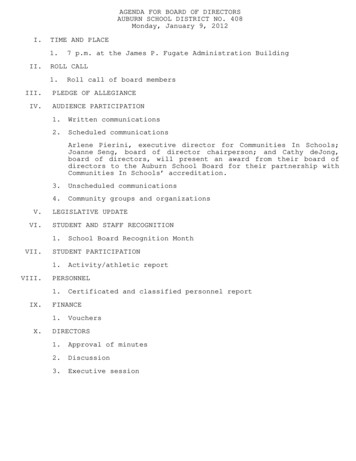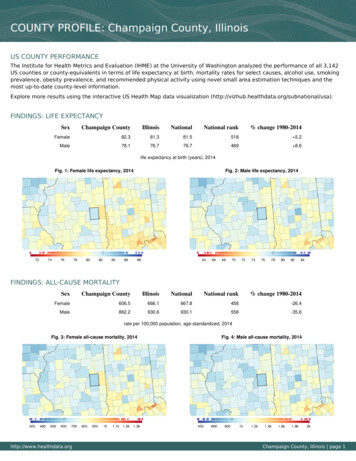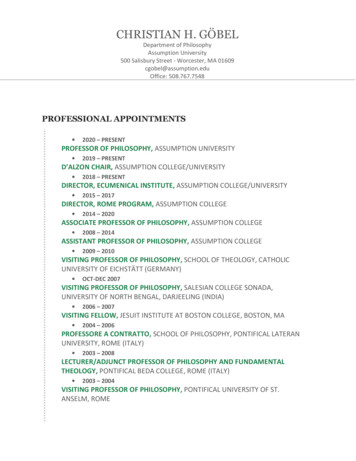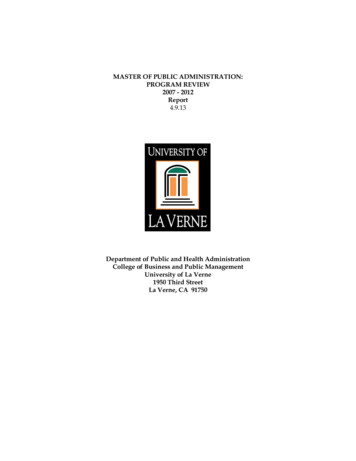
Transcription
MASTER OF PUBLIC ADMINISTRATION:PROGRAM REVIEW2007 - 2012Report4.9.13Department of Public and Health AdministrationCollege of Business and Public ManagementUniversity of La Verne1950 Third StreetLa Verne, CA 91750
iiTable of ContentsCover Page . iTable of Contents . iiSummary of Tables . iiiSummary of Figures . ivExecutive Summary . vProgram Summary . viiI.Introduction . 8II.The La Verne MPA Program . 9Background. 9Mission and Program Objectives . 11Curriculum . 15Student Population . 18Class Size and Faculty Resources . 19Other Public Service Programs . 20Opportunities and Threats . 22III. Mission Process and Assessment . 24Mission Assessment Process . 24Teaching Evaluations . 25Annual Faculty Evaluations . 26Alumni Evaluations . 26Advisory Board . 26Annual Program Reviews . 27Graduate Exit Survey . 27Course Embedded Program Assessment . 28Guiding Performance . 30IV. Faculty . 33V.Admission of Students . 43VI. Student Services . 47VII. Graduates . 51VIII. Supportive Services and Facilities . 53IX. Summary and Recommendations. 56X.Appendix . 60
iiiSummary of TablesTable 1. MPA Assessment Matrix . 12Table 2. Learning Outcome Measurement Grid for the MPA Program . 15Table 3. Characteristics of Curriculum Components . 16Table 4. MPA Graduates Concentrations . 17Table 5. MPA Class Size . 19Table 6. University of La Verne MPA Enrollment, 2001-2011 (Fall Enrollment) . 20Table 7. University of La Verne MPA Faculty . 20Table 8. Regional Master’s Degree Programs in Public Administration and Public Policy . 21Table 9. MPA Outcome Assessment Summary Report (Academic Year 2008 2012) . 29Table 10. Selected Changes to the MPA Program: 2007-2012 . 32Table 11. Faculty Nucleus . 33Table 12. Percentage of Courses Taught by Full and Part time Faculty . 34Table 13. Faculty Diversity . 40Table 14. MPA Program Administration . 41Table 15. MPA Admissions Records . 44Table 16. Employment Statistics of 2010-11 and 2011-12 of Admitted MPA Students . 45Table 17. MPA Program Size: Number of Students Registered in Fall Terms . 46Table 18. MPA Students Admitted on Probationary Status. 46Table 19. Graduation Rates: Graduating Students From 2006 (Five Years From Annual ReviewDate of 2011) . 48Table 20. Graduation Rates: Graduating Students From 2007 (Five Years From Annual ReviewDate of 2012) . 49Table 21. Employment Statistics of 2010-11 and 2011-12 MPA Graduates . 51Table 22. Nucleus Faculty Salary Data. 53Table 23. Adjunct Faculty Compensation . 54
ivSummary of FiguresFigure 1. The Role of the Assessment System . 25Figure 2. Assessment Processes and Frequency . 25
vExecutive SummaryThis report has reviewed the history, mission, curriculum and students of the University ofLa Verne MPA program. This report has relied on evidence developed though an assessmentprocess that utilizes alumni and graduate surveys, graduate exit surveys, course embeddedassessment, student evaluations of professors, and a comparison of the La Verne Program tosimilar programs in Southern California.Program StrengthsBased on the information provided in this report, the following areas indicate what weconsider to be the central strengths of the La Verne MPA Program:1.2.3.4.5.6.7.University and MPA Program MissionLongevity (40 Years)Faculty Research, Teaching and Professional AssociationsLocation and Regional ConnectionsCurriculumClass Size and ScheduleAlumniThe mission of the program is in good order and will take on some added dimensions in thecoming years to that will take advantage of the La Verne Program niche and positively impactthe region. An important focus of the program will be to create public value through research andservice.Program ChallengesThis report outlines 14 findings related to program design and implementation. Based onthese findings, the following challenges to the program are noted: Loss of Geographic Monopoly (on-line education challenges)Depth of on-line technology and supportProgram Promotion and Recent Downturn in EnrollmentAnalytic Support (Statistical Lab)Student Support ServicesCareer Services and Student NetworkingCurricular Enhancement in program concentration areasProgram RecommendationsThe La Verne MPA is a respected program by peers, alumni and students. In order toaddress the challenges to the program, the following steps are recommended for the La VerneMPA program in order to strengthen its unique niche in the Southern California region. We cando so by responding to the findings outlined in this report. In doing so, the program makes thefollowing three recommendations and corresponding activities:
viDevelop Networks for Students and Stakeholders:1. Developing an Honors Society Chapter2. Become a California – ICMA Chapter3. Find a systematic and on-going way to incorporate practitioners into the curriculumand co-curricular work of the program. Options include guest lectures, mentorship,symposium, city-manager-in-residence program, ICMA student led organization4. Graduate financial assistance in the form of tuition discounts (assistantships) andscholarships should be part of attracting, assisting and maintaining graduatestudents in the MPA program5. Develop a student mentoring program with the guidance and participation of theAdvisory BoardEnhance Curriculum and Career Support for Students1. Develop a Statistical Lab in support of statistical assistance for students andstatistical and data base management support for faculty2. Develop and strengthen the careers service center for student to access and seekassistance for career development.3. Strengthen International Experience opportunities4. Developing a Strong Alumni Relations Program5. Strengthen program competencies in public management and leadership,administrative law and public finance.Be responsive to the needs of stakeholders1. Develop public administration certificates for ongoing development of professionalsin the public service systems2. Strengthen or develop concentrations (non-profit, economic development, policy,environmental administration) in the MPA program.In moving forward and creating public value through research and service, the above areaswill need our attention in the coming years. In so doing, the program needs to be concernedwith program capacity, as in implementing these three recommendations will call uponadditional resources or a shift of emphasis in current resources.Jack W. Meek,Director, Master of Public AdministrationUniversity of La VerneFaculty Contributors: Dr. Suzanne Beaumaster, Dr. Marcia Godwin, Dr. Keith Schildt, Dr.Soomi Lee, Dr. Adrian Velazquez, Dr. Lisa Saye, Dr. Matt Witt.Administrative Staff Contributors: Carrie Crittenden, Executive Assistant to the Dean, ClaudeBahouth, Graduate Public Administration Program Administrator/Advisor, Li-Fen Liu,Assessment Analyst.
viiProgram SummaryItemData1. Title of degreeMaster of Public Administration2. Off-campus locationsNone3. Number of credits normally required for degree39 semester hours4. Total credits in required courses39 semester hours5. Total credits in elective coursesNone6. Specializations advertised as availableThree7. Number of credits which can be reduced forundergraduate educationNone8. Number of credits which can be reduced for significantprofessional experienceNone9. Number in faculty nucleus810. Number of students in degree program (2011 - 2012)11. Is there a thesis or major professional report required?Full-Time: 47Part-Time: 51Total: 98Yes, a capstone project is requiredas part of the Graduate Seminarcourse.12. Is a comprehensive examination required?No.13. Is an internship available? Is it required?Yes. Internships are required ofstudents without experience inpublic or non-profit service.
8I. IntroductionThe mission of the University of La Verne’s Master of Public Administration program is to offer aninnovative and practical curriculum that stresses intellectual and theoretical foundations for professionalspreparing to take on socially responsible roles in public leadership and service.The mission will be achieved through a curriculum that emphasizes:(1)(2)(3)(4)(5)The effective use of public resourcesThe changing context (contextual nature) of public administrationAnalytic and decision-making capacityPractice of public administration in diverse public organizationsEthical dimensions of public serviceThe NASPAA universal competencies are framed within the La Verne MPA mission and theabove areas of emphasis. These competencies include the following:(1)(2)(3)(4)(5)To lead and manage in public governance;To participate in and contribute to the public policy process;To analyze, synthesize, think critically, solve problems and make decisions;To articulate and apply a public service perspective; andTo communicate and interact productively with a diverse and changing workforce andcitizenry.The MPA program at the University of La Verne strengthens students’ management andleadership capabilities by providing them with a curriculum that emphasizes competenciesnecessary for professionals in public service positions and preparing them for the increasinglyinterconnected and networked environment of public service.The program is offered on the main campus in La Verne, California. The MPA degree ishoused within the Department of Public and Health Services Administration. The Departmentis one of four in the College of Business and Public Management.The first MPA admission was in September 1973 with the first MPA graduation in May1974. The close of the 2011- 2012 academic year represented the 39 years of program operation.
9II. The La Verne MPA ProgramBackgroundInstitutional setting. The University of La Verne, founded in 1891, is a private liberal artsand professional education institution located in the City of La Verne in the Pomona Valley andSan Gabriel Valley area, 35 miles east of Los Angeles. The area served by the main campusincludes multiple governments and public agencies, including approximately 42 cities.The MPA Program at the University of La Verne consists of weeknight and occasionalSaturday courses. Four terms are scheduled per year (Summer, Fall, Winter, and Spring) andthe program is considering offering a course in the mini-term after the Fall and before theWinter sessions. Typical student load is one or two courses per term. On rare occasions,students may take up to three courses per term with the advisor’s permission and facultyapproval, for a total of nine semester units. However, this is rare and only permitted underextraordinary circumstances, such as availability of future courses, job requirements, provenacademic ability, and financial considerations.Students enroll for courses held at the main campus in the city of La Verne. The Universityof La Verne presently has over 8,500 students enrolled in its undergraduate, graduate andprofessional education programs. The University of La Verne has the following colleges: College of Arts and SciencesCollege of Business and Public ManagementCollege of Education and Organizational LeadershipCollege of LawThe University has several branch campuses in Central and Southern Californiaadministered through University of La Verne Regional Campuses.Historical development of the program. The MPA Program began in the early 1970s whenthe History/Political Science program at the University of La Verne broadened its offerings inthe field by establishing a Master in Public Administration program in an off-campus learningcenter. In 1979, the Department of Public Administration was established.Professor Allan Lachman, a political scientist from U.C. Santa Barbara, joined the faculty andbecame the first Chair of the Department. Five full-time faculty members served in thediscipline, including one in Health Services Administration.The initial design of the MPA program was to focus on leadership and public managementfor in-service students in local, state and federal agencies located in the Southern Californiaregion. In 1983, the Department of Public Administration offered the MPA program through acohort model in several locations near the campus.Professor Jack W. Meek became Department Chair in 1988 and the MPA program wasredesigned and scheduled for on-campus only management in 1989. This redesign ended alloff-campus MPA program locations.
10In 1994, the MPA Advisory Board was created under the direction of Professor RaymondGarubo, the MPA Chair. In 1995, the Department of Public Administration joined the NationalAssociation of Schools of Public Administration and Affairs (NASPAA) as a member. The MPAprogram’s initial self-study in 1999 and was accredited by NASPAA in 2000.Professor Keith Schildt served as Chair of the MPA Program from 2001 until 2007. In 2003, aspart of ongoing reorganization efforts at the University, the School of Public Affairs and HealthAdministration (which had included the MPA program) was merged with the School ofBusiness to create the College of Business and Public Management. The Department of Publicand Health Administration was created in 2004, along with two other departments within theCollege.Professor Jack W. Meek has served as Chair of the MPA Program from 2007 to the currentyear. The MPA Program is housed in the Department of Public and Health Administrationchaired by Professor Keith Schildt. The program was reaccredited by NASPAA in 2008 and willundergo reaccreditation in 2013.Program setting and foundation. Geographically, the Los Angeles area includes wealthyresidential enclaves, growing edge cities, aging suburbs, immigrant communities, and urbanareas in transition. Overlaid in this environment are a myriad of formal government agencies,quasi-governmental agencies, non-profit organizations, and volunteer organizations. Asdiscussed in our 1999 self-study, there are few areas in the world with the wide variety of cities,counties and special water, flood control, air quality, and other districts that one finds inSouthern California. This region has also been a leader in the development of public-privatepartnerships, formal and informal inter-local agreements, non-profit organizations carrying outpublic activities either by contract with governments or on the basis of fees for service or otheralternative institutional forms. Therefore, the MPA program broadly defines public service and ourcourse offerings reflect our approach to addressing these areas of study within our metropolitan region.As discussed in the 1999 self-study, the educational philosophy upon which the MPA isbased includes an emphasis on values and ethics. We are concerned not only with theeffectiveness of our graduates as public officials and leaders, but also as ethical professionals.The University’s mission statement embodies a concern for the development of students asindividuals who appreciate other cultures and points of view, understand the merits of lifelonglearning, and engage in community service. The University is designated as a Hispanic ServingInstitution (HIS). The University is extending its mission through development of the La VerneExperience programs for both undergraduate and graduate students that emphasize civicengagement, experiential learning, cross-course and interdisciplinary learning.The MPA faculty incorporate these and other public service values into their approach toteaching and in the personal attention to student development offered in our program. Thefostering of ethical responsibility is a major part of the faculty discussions on the missionstatement and the orientation of our program. As a department, we are developing civicprofessionalism as a guiding theme to highlight the importance of developing a public service
11orientation, encouraging public service as a vocation, and improving public participation indecision-making.The MPA curriculum balances theory and practice. For students to be prepared for positionsof leadership in the public and non-profit sector, they need to have a broad understanding of avariety of theoretical concepts and professional competencies as well as to develop a broad andcritical perspective of public administration leadership and management.Mission Statement and Program ObjectivesThe mission of the University of La Verne’s Master of Public Administration program is to offer aninnovative and practical curriculum that stresses intellectual and theoretical foundations for professionalspreparing to take on socially responsible roles in public leadership and service.The mission will be achieved through a curriculum that emphasizes:(1)(2)(3)(4)(5)The effective use of public resourcesThe changing context (contextual nature) of public administrationAnalytic and decision-making capacityPractice of public administration in diverse public organizationsEthical dimensions of public serviceThe NASPAA universal competencies are framed within the La Verne MPA mission and theabove areas of emphasis. These competencies include the following:(1)(2)(3)(4)(5)To lead and manage in public governance;To participate in and contribute to the public policy process;To analyze, synthesize, think critically, solve problems and make decisions;To articulate and apply a public service perspective; andTo communicate and interact productively with a diverse and changing workforce andcitizenry.The MPA program at the University of La Verne strengthens students’ management andleadership capabilities by providing them with a curriculum that emphasizes competenciesnecessary for professionals in public service positions and preparing them for the increasinglyinterconnected and networked environment of public service.The public services values have been established by the La Verne MPA faculty andembedded within the competencies established to meet the program mission and universalcompetencies of NASPAA programs. For an outline of the public service articulated in theprogram mission, see Table 1 below and Appendix xiii.A curriculum map of program learning outcomes, universal competencies and publicservice values embedded in selected courses is provided on the following table.
12Table 1. MPA Assessment MatrixLa ective 1: Utilization ofpublic resources in efficient& effective waysObjective 2: Evaluate theeffectiveness of planning,procurement, andimplementation of IT in apublic sector organizationThe EffectiveUse of PublicResourcesUnderstand theintra and interorganizationalaspects ofpublicadministrationUnderstand theinherent socialrole and ethosfor the public,private, andnonprofitsectorsUnderstand therolequantitativeanalysis playsin publicadministrativedecisionmakingUnderstand theimplications ofdiversity gnedCourseAssignedElectiveCoursesPADM 534Management ofPublic FundsPublic fficiency andobjectivelyPADM 584Managing IT inPublicOrganizationsLead &Manage inPublicGovernanceObjective 3: Appraise theorganizational environment,both internal and external,as well as the culture,politics and institutionalsettingArticulate,Apply PublicServicePerspectiveObjective 4A: Articulate theunique nature of publicadministration, the role ofthe public administrator,and the contextual elementsthat differentiate the publicfrom the nonprofit andprivate sectors.Objective 4B Articulate theunique mission of a nonprofit organization and itsprograms, organizationalstructure and governanceAnalyze,Synthesize &DecisionMakingObjective 5: Employanalytical tools forcollecting, analyzing,presenting, and interpretingdata, including appropriatestatistical concepts andtechniquesPADM 582QuantitativeAnalysis forPublicAdministrationObjective 6: Identify anddiscuss the significantstrategic human resourcesmanagement implicationsfor managing diversityPADM 530HumanResourceManagementActing ethicallyso as to upholdthe public trustObjective 7: To demonstratecomprehensiveunderstanding of and skillapplying the EthicalProblem Solving ModelPADM 555EthicsPursuing thepublic interestwithaccountabilityandtransparencyObjective 8: Describe andwork within theinstitutional, structural, andpolitical contexts of policymakingPADM 533PolicyFormation &AnalysisCommunicatewith a DiverseWorkforceUnderstand theconcepts offairness andjustice in publicserviceParticipate inthe PublicPolicy ProcessPADM 531 Org,TheoryPADM 538CollaborativePAPADM 501PublicAdministrationand SocietyMGMT 533Accounting &ComplianceforNonprofitsDemonstratingrespect, equityand fairness indealing withcitizens andfellow publicservants
13The Master of Public Administration learning goals translate into the following programobjectives and learning outcomes for the MPA:Objective 1. Utilization of public resources in efficient & effective ways.Learning outcomes for Objective 1 (PADM 534):1-1. Assess basic understanding concepts of market failure, public goods, externalities,and reasons for government intervention.1-2. Assess understanding of interaction between incentive structure and individualbehavior and of tradeoffs between efficiency and equity in the U.S. tax system.1-3. Competency in understanding the issues in public service, and presenting importantempirical studies on the topics chosen by students.Objective 2. Evaluate the effectiveness of planning, procurement, and implementation of ITin a public sector organization.Learning outcomes for Objective 2 (PADM 584):2-1. Articulates the primary issues/problem related to IT planning illustrated in the case.2-2. Articulates the primary issues/problem related to IT acquisition illustrated in thecase.2-3. Articulates the primary issues/problem related to IT implementation illustrated inthe case.2-4. Analyzes alternatives for addressing specific IT concerns from the organizationsperspective.2-5. Completes a SWOT analysis that analyzes the specifics of the assigned case.Objective 3. Appraise the organizational environment, both internal and external, as wellas the culture, politics and institutional setting.Learning outcomes for Objective 3 (PADM 531):3-1. Analyzes organizational theory as it is applied to public sector organizations.3-2. Evaluates methods of managing and enhancing culture in the workplace based oncontemporary theory.3-3. Applies theories to organizations to illustrate efficacy in practices.3-4. Analyzes theories of decision-making for application in the public sector.3-5. Thinks critically and communicates effectively in organizational settings.Objective 4A. Articulate the unique nature of public administration, the role of the publicadministrator, and the contextual elements that differentiate the public from the nonprofit andprivate sectors.Learning outcomes for Objective 4A (PADM 501):4-1. Be able to define the unique nature of public administration through the use of keypublic administration concepts, identifying the role of the public administrator and theirdecision-making alternatives in the public administrative context.
144-2. Understand the nature of the issue and its operational definition, the challenges andconsequences of policy issues, the adequacy of administrative processes within anadministrative context, and the differences with nonprofit or private processes.Objective 4B. Articulate the unique mission of a non-profit organization and its programsorganizational structure and governanceLearning outcomes for Objective 4B (MGMT 533):4-1. Articulate a sustainable market niche for a non-profit organization4-2. Develop a functioning governance structure including a board of directors4-3 Identify specific organizational programs related to the mission4-4 Establish a management structure that implements organizational programsObjective 5. Employ analytical tools for collecting, analyzing, presenting, and interpretingdata, including appropriate statistical concepts and techniques.Learning outcomes for Objective 5 (PADM 582):5-1. Summarize and describe quantitative information in several different forms.5-2. Understand, perform, present, and interpret inferential statistics.5-3. Understand and interpret multiple regression results.Objective 6. Identify and discuss the significant Strategic Human Resources ManagementImplications for Managing Diversity.Learning outcomes for Objective 6 (PADM 530):6-1. Demonstrates the understanding of demographic and contextual characteristics ofdiverse organizations.6-2. Assesses the potential benefits and barriers of organizational diversity.6-3. Distinguishes and exemplifies organizational approaches to diversity.Objective 7. To demonstrate comprehensive understanding of and skill in applying theEthical Problem Solving Model.Learning outcomes for Objective 7 (PADM 555):7-1. Clarify the facts of the situation and how these materialize as interests of allpertinent stakeholders.7-2. Determine Driscoll Scanlon’s duty considering the obligations and responsibilities ofhis position and professional role.7-3. Analyze Scanlon’s actions according to each of the three ethical approaches: virtuebased, principle based, results oriented.7-4. Assess Scanlon’s actions and performance based on available opti
University of La Verne 1950 Third Street La Verne, CA 91750. ii . administrative law and public finance. Be responsive to the needs of stakeholders 1. Develop public administration certificates for ongoing development of professionals in the public service systems 2. Strengthen or develop concentrations (non-profit, economic development, policy,

